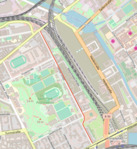The Speakeasy Club
1966 establishments in England1978 disestablishments in EnglandFormer buildings and structures in the City of WestminsterFormer music venues in LondonMusic venues completed in 1966 ... and 2 more
Rock music venuesUse British English from September 2016
The Speakeasy Club, also known as The Speak, was a club situated at 48 Margaret Street, London, England, and served as a late-night meeting place for the music industry from 1966 to June 1978. The club took its name and theme from the speakeasies of the American Prohibition era. The club was owned by Iraqi-born entrepreneur David Shamoon, along with Blaises and The Revolution Club.
Excerpt from the Wikipedia article The Speakeasy Club (License: CC BY-SA 3.0, Authors).The Speakeasy Club
Margaret Street, City of Westminster Fitzrovia
Geographical coordinates (GPS) Address Nearby Places Show on map
Geographical coordinates (GPS)
| Latitude | Longitude |
|---|---|
| N 51.516666666667 ° | E -0.14138888888889 ° |
Address
Robert Irving Burns
Margaret Street 23-24
W1W 8SG City of Westminster, Fitzrovia
England, United Kingdom
Open on Google Maps










